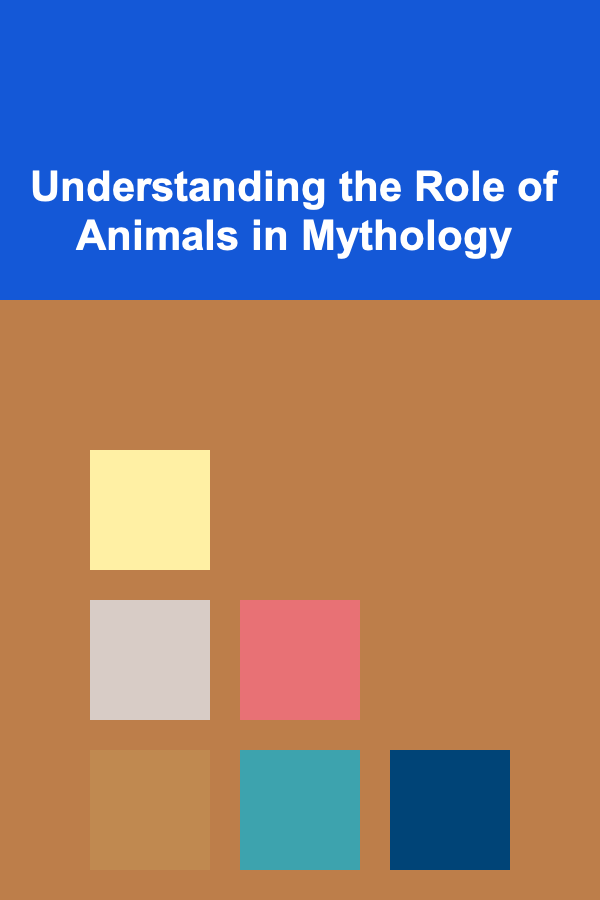
Understanding the Role of Animals in Mythology
ebook include PDF & Audio bundle (Micro Guide)
$12.99$6.99
Limited Time Offer! Order within the next:

Animals have held a prominent and multifaceted role in mythology across cultures and throughout history. Their presence transcends simple representation; they serve as powerful symbols, embodying essential qualities, connecting the earthly and spiritual realms, and even acting as active agents in shaping narratives. To understand the role of animals in mythology is to unlock a deeper understanding of human culture, belief systems, and our complex relationship with the natural world.
Animals as Symbols of Archetypal Qualities
One of the most significant functions of animals in mythology is their capacity to represent archetypal qualities and abstract concepts. The traits associated with specific animals are often amplified and projected onto gods, heroes, and even entire societies, revealing deeply ingrained cultural values and aspirations.
Consider the lion. Universally, it is associated with courage, strength, royalty, and leadership. In Egyptian mythology, Sekhmet, the warrior goddess and protector of pharaohs, is depicted with the head of a lioness, embodying her fierce power and unwavering commitment to safeguarding the kingdom. Similarly, the lion is a symbol of kingship in many African cultures, often appearing in royal regalia and narratives about powerful rulers. The lion's presence in mythology serves as a shorthand for these desired traits, communicating complex ideas quickly and effectively.
The serpent, on the other hand, often embodies duality. It can represent both healing and destruction, wisdom and treachery. In Greek mythology, the serpent is associated with Asclepius, the god of medicine, whose staff is entwined with a single snake, a symbol still used in the medical profession today. This association highlights the serpent's connection to healing and regeneration. However, the serpent also represents temptation and forbidden knowledge, as seen in the biblical story of Adam and Eve, where the serpent leads them to eat the fruit of the Tree of Knowledge, resulting in their expulsion from the Garden of Eden. This dualistic representation reflects the complex and often contradictory nature of life itself.
The wolf occupies a similarly nuanced position. It can be seen as a symbol of wildness, danger, and untamed nature, often representing the chaotic forces that threaten civilization. Yet, the wolf also embodies loyalty, family, and survival. In Roman mythology, Romulus and Remus, the founders of Rome, were suckled by a she-wolf, highlighting the wolf's protective and nurturing qualities. This duality underscores the complex relationship between humanity and the natural world, acknowledging both its dangers and its potential for providing sustenance and support.
Other animals and their symbolic associations include: the owl (wisdom, knowledge, and prophecy), the eagle (power, freedom, and divine connection), the fox (cunning, trickery, and adaptability), the dove (peace, love, and purity), and the bear (strength, courage, and motherhood). Understanding these animal symbols provides valuable insights into the cultural values and beliefs that underpin the myths in which they appear.
Animals as Mediators Between Worlds
Beyond representing abstract concepts, animals often serve as mediators between the human world and the spiritual realm, acting as messengers, guides, and even intermediaries between gods and humans. This role highlights the perceived connection between the natural and supernatural worlds, suggesting that animals possess a unique ability to traverse these boundaries.
Birds, in particular, frequently occupy this role due to their ability to fly, which is often interpreted as a symbol of spiritual transcendence. In many cultures, birds are seen as messengers of the gods, carrying prayers and delivering divine pronouncements. The raven , for example, plays a significant role in Norse mythology, serving as Odin's companion and informant, flying across the world to gather knowledge and report back to the Allfather. Similarly, the dove is often associated with the Holy Spirit in Christian tradition, representing divine grace and spiritual guidance.
Animals can also act as spirit guides, leading individuals on journeys of self-discovery and transformation. In shamanic traditions, animal spirits are often invoked to assist shamans in their travels to the spirit world, providing protection and guidance. These animal spirits, often referred to as "power animals," are believed to possess unique knowledge and abilities that can be harnessed by the shaman to heal and guide others. The choice of animal spirit is often significant, reflecting the individual's personality, strengths, and weaknesses.
Furthermore, some animals are believed to possess the ability to shapeshift, blurring the lines between the animal and human realms. Werewolves, for instance, are a common figure in folklore across many cultures, representing the primal and animalistic instincts that lie dormant within humans. Shapeshifting can also symbolize transformation and the ability to adapt to changing circumstances. By embodying both human and animal characteristics, shapeshifters challenge the boundaries between these categories, highlighting the interconnectedness of all living beings.
The horse, often associated with speed, strength, and freedom, has also played a prominent role as a mediator, particularly as a vehicle for gods and heroes. In Greek mythology, Pegasus, the winged horse, carries heroes like Bellerophon on epic adventures. The horse's ability to transport individuals across vast distances and into the heavens symbolizes its role in bridging the earthly and divine realms.
Animals as Ancestors and Totems
In many indigenous cultures, animals are viewed as ancestors and totems, holding a special connection to specific clans or tribes. These animals are not merely symbols; they are considered to be living relatives, deserving of respect and reverence. This belief system underscores the interconnectedness of all life and the importance of maintaining a harmonious relationship with the natural world.
Totem animals often represent the founding ancestors of a particular clan or tribe, providing a sense of identity and belonging. These animals are often depicted in artwork, ceremonies, and oral traditions, serving as a constant reminder of the group's origins and cultural heritage. Respecting the totem animal is considered essential for the well-being of the community, as it is believed to possess the power to protect and guide its descendants.
Animal ancestors can also appear in creation myths, playing a crucial role in shaping the world and giving rise to humanity. In some Native American traditions, for example, the raven is credited with creating the world, bringing light to the darkness and shaping the landforms. These creation myths highlight the animal's agency and intelligence, portraying them as active participants in the cosmic drama.
Practices like animal sacrifice, though sometimes misunderstood, often stem from this deep-seated respect and connection with animals. Sacrifices are not necessarily acts of cruelty but rather offerings made to appease the gods or to honor the animal spirits. The act of sacrifice is often seen as a way to restore balance to the natural world and to ensure the continued prosperity of the community. The specific animal chosen for sacrifice is often significant, reflecting its symbolic association and its perceived connection to the divine.
Understanding the role of animals as ancestors and totems provides crucial insights into the worldview of many indigenous cultures, revealing their profound respect for the natural world and their belief in the interconnectedness of all life.
Animals as Agents of Transformation and Moral Lessons
Beyond their symbolic and spiritual roles, animals often serve as active agents within mythological narratives, driving the plot forward, influencing the actions of characters, and ultimately teaching valuable moral lessons. They are not merely passive figures but can be cunning tricksters, loyal companions, or formidable adversaries.
Trickster figures, often embodied by animals like the coyote or the rabbit, are common in mythology across many cultures. These characters are known for their mischievous behavior, their ability to defy social norms, and their penchant for causing chaos. While their actions may seem destructive on the surface, trickster figures often play a crucial role in challenging established power structures, exposing hypocrisy, and ultimately promoting social change. Their unpredictable nature forces individuals to question their assumptions and to think critically about the world around them.
Loyal animal companions, on the other hand, represent the power of friendship, loyalty, and selflessness. In many fairy tales and folktales, animals assist the hero or heroine on their quest, providing valuable guidance, protection, and companionship. These animal companions often possess unique abilities that complement the hero's skills, allowing them to overcome seemingly insurmountable obstacles. The bond between the hero and their animal companion often symbolizes the importance of teamwork, trust, and mutual respect.
Animals can also serve as moral exemplars, demonstrating the consequences of specific actions and behaviors. Fables, in particular, often use animals to illustrate moral lessons, highlighting the importance of virtues like honesty, kindness, and perseverance. Aesop's Fables, for example, are filled with animal characters who embody specific traits and whose actions ultimately lead to either success or failure. These fables serve as a powerful tool for teaching children and adults alike about the importance of ethical behavior.
The interactions between humans and animals in mythology often serve as a microcosm of the broader relationship between humanity and the natural world. By observing how characters treat animals, we can gain insights into the cultural values and beliefs surrounding environmental stewardship, respect for other species, and the importance of maintaining a balance between human needs and the preservation of the natural world.
The Impact of Culture and Context on Animal Symbolism
It is crucial to recognize that the meaning and significance of animals in mythology are heavily influenced by cultural context. The same animal can have vastly different symbolic associations in different cultures, reflecting their unique histories, environments, and belief systems. Therefore, a nuanced understanding of the cultural context is essential for interpreting the role of animals in mythology accurately.
For example, the owl , often associated with wisdom and knowledge in Western cultures, is sometimes viewed as an omen of death or bad luck in other parts of the world. This difference in interpretation likely stems from the owl's nocturnal habits and its association with the dark, mysterious aspects of the natural world. Similarly, the bat, often associated with darkness and evil in Western culture, is considered a symbol of good luck and prosperity in Chinese culture, due to the phonetic similarity between the word "bat" and the word "fortune" in Chinese.
The environment also plays a significant role in shaping animal symbolism. Cultures that live in close proximity to certain animals are more likely to develop complex and nuanced relationships with them, leading to a deeper understanding of their behavior and their potential symbolic meanings. For example, cultures that rely on reindeer for sustenance and transportation are likely to have a rich mythology surrounding these animals, viewing them as essential to their survival and cultural identity.
Furthermore, the historical context can also influence animal symbolism. The introduction of new animals into a culture can lead to the development of new myths and legends, as people attempt to understand the nature and significance of these creatures. The horse, for example, played a transformative role in the cultures of many indigenous peoples in the Americas after its introduction by Europeans, becoming a symbol of power, freedom, and mobility.
Therefore, when analyzing the role of animals in mythology, it is essential to consider the cultural, environmental, and historical context in which the myths originated. Generalizing about animal symbolism without taking these factors into account can lead to inaccurate and misleading interpretations.
Conclusion
The role of animals in mythology is far more complex and nuanced than simple representation. They serve as powerful symbols of archetypal qualities, mediators between the human and spiritual realms, ancestors and totems, agents of transformation, and teachers of moral lessons. By understanding these multifaceted roles, we can gain a deeper appreciation for the richness and complexity of human culture and our enduring relationship with the natural world.
Furthermore, studying animal symbolism in mythology encourages us to consider the impact of culture and context on shaping our perceptions of the natural world. Recognizing that the same animal can have vastly different meanings in different cultures promotes a more inclusive and respectful understanding of diverse perspectives. Ultimately, exploring the role of animals in mythology can help us to reconnect with the natural world, to appreciate its beauty and power, and to recognize our responsibility to protect it for future generations.

Effective Strategies for Recruitment Consultants: Building Successful Hiring Processes
Read More
How to Create a Checklist for Ensuring Mobile Responsiveness in Your Emails
Read More
How To Practice Yoga for Flexibility in Hips
Read More
How To Master Character Design for Illustration
Read More
Practicing Mindfulness for Calmness: A Comprehensive Guide
Read More
10 Tips for Winning at Euchre Every Time
Read MoreOther Products

Effective Strategies for Recruitment Consultants: Building Successful Hiring Processes
Read More
How to Create a Checklist for Ensuring Mobile Responsiveness in Your Emails
Read More
How To Practice Yoga for Flexibility in Hips
Read More
How To Master Character Design for Illustration
Read More
Practicing Mindfulness for Calmness: A Comprehensive Guide
Read More